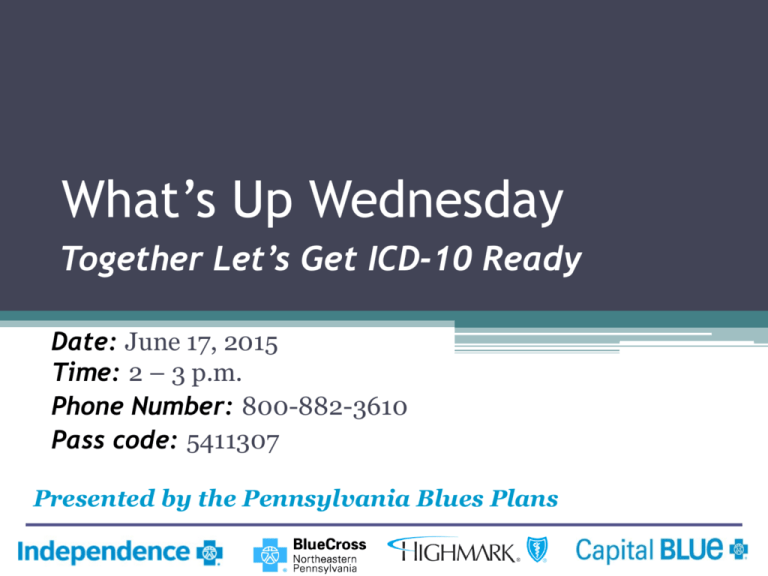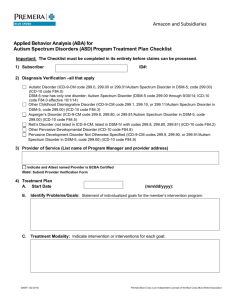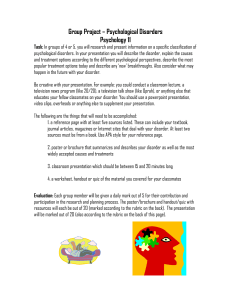Presentation - Independence Blue Cross
advertisement

What’s Up Wednesday Together Let’s Get ICD-10 Ready Date: June 17, 2015 Time: 2 – 3 p.m. Phone Number: 800-882-3610 Pass code: 5411307 Presented by the Pennsylvania Blues Plans 2 What’s Up Wednesday and ICD-10 Increase Collaboration, communication, education and coordination between hospitals, physicians, payers and vendors Expand Understanding of the current state of ICD-10, recent regulatory decisions and industry perspectives Raise Awareness and understanding of the unique challenges that ICD-10 brings to the entire health care industry Provide Tools, techniques, best practices, and helpful hints that can be used to support ICD-10 implementation Please remember that during the call all attendees are on mute except for any guest speakers and panelists. Please e-mail any questions you would like addressed during or after the call to ICD10ProviderCommunication@capbluecross.com. 3 Today’s ICD-10 Agenda Insurance Implications of Implementation of DSM-5 Kathleen C. Dougherty, M.D., D.F.A.P.A. Chair, Dept. of Psychiatry, Lancaster General Health Director, Behavioral Health Service Line, LGPA Behavioral Health AAPC – Information for getting ICD-10 Ready Rhonda Buckholtz VP, ICD-10, AAPC CPC, CPMA, CRC, CPC-I, CHPSE Insurance Implications of Implementation of DSM-5 Kathleen C. Dougherty, M.D., D.F.A.P.A. 5 DSM-5 Classification Criteria and Use Slides courtesy of: David J Kupfer, M.D. Darrel A Regier, M.D., M.P.H. William E Narrow, M.D., M.P.H. American Psychiatric Association Conceptual Development of DSM DSM-I Presumed etiology DSM-5 New approaches considered (dimensional, spectra, developmental, culture, impairment thresholds, living document) DSM-III Reconceptualization Explicit criteria (emphasis on reliability rather than validity) DSM-II Glossary definitions DSM–IV Requires clinically significant distress or impairment DSM-III-R Criteria broadened Most hierarchies dropped Copyright © 2013. American Psychiatric Association. DSM-5 Structure • Section I: DSM-5 Basics • Section II: Essential Elements: Diagnostic Criteria and Codes • Section III: Emerging Measures and Models • Appendix (includes highlights of changes, glossaries) • Index Copyright © 2013. American Psychiatric Association. Section I • • • • • Brief DSM-5 developmental history Guidance on use of the manual Definition of a mental disorder Cautionary forensic statement Brief DSM-5 classification summary Copyright © 2013. American Psychiatric Association. DSM-5 Structure • Section I: DSM-5 Basics • Section II: Essential Elements: Diagnostic Criteria and Codes • Section III: Emerging Measures and Models • Appendix (includes highlights of changes, glossaries) • Index Copyright © 2013. American Psychiatric Association. Changes in Specific DSM Disorder Numbers; Combination of New, Eliminated, and Combined Disorders (net difference = -15) Specific Mental Disorders* DSM-IV DSM-5 172 157 *NOS (DSM-IV) and Other Specified/Unspecified (DSM-5) conditions are counted separately. Copyright © 2013. American Psychiatric Association. New and Eliminated Disorders in DSM-5 (net difference = +13) New Disorders 1. 2. 3. 4. 5. 6. 7. 8. 9. 10. 11. 12. 13. 14. 15. Social (Pragmatic) Communication Disorder Disruptive Mood Dysregulation Disorder Premenstrual Dysphoric Disorder (DSM‐IV appendix) Hoarding Disorder Excoriation (Skin‐Picking) Disorder Disinhibited Social Engagement Disorder (split from Reactive Attachment Disorder) Binge Eating Disorder (DSM‐IV appendix) Central Sleep Apnea (split from Breathing‐Related Sleep Disorder) Sleep-Related Hypoventilation (split from Breathing‐Related Sleep Disorder) Rapid Eye Movement Sleep Behavior Disorder (Parasomnia NOS) Restless Legs Syndrome (Dyssomnia NOS) Caffeine Withdrawal (DSM‐IV Appendix) Cannabis Withdrawal Major Neurocognitive Disorder with Lewy Body Disease (Dementia Due to Other Medical Conditions) Mild Neurocognitive Disorder (DSM‐IV Appendix) Eliminated Disorders 1. Sexual Aversion Disorder 2. Polysubstance‐Related Disorder Combined Specific Disorders in DSM-5 (net difference = -28) 1. Language Disorder (Expressive Language Disorder & Mixed Receptive Expressive Language Disorder) 2. Autism Spectrum Disorder (Autistic Disorder, Asperger’s Disorder, Childhood Disintegrative Disorder, & Rett’s disorder—PDD-NOS is in the NOS count) 3. Specific Learning Disorder (Reading Disorder, Math Disorder, & Disorder of Written Expression) 4. Delusional Disorder (Shared Psychotic Disorder & Delusional Disorder) 5. Panic Disorder (Panic Disorder Without Agoraphobia & Panic Disorder With Agoraphobia) 6. Dissociative Amnesia (Dissociative Fugue & Dissociative Amnesia) 7. Somatic Symptom Disorder (Somatization Disorder, Undifferentiated Somatoform Disorder, & Pain Disorder) 8. Insomnia Disorder (Primary Insomnia & Insomnia Related to Another Mental Disorder) 9. Hypersomnolence Disorder (Primary Hypersomnia & Hypersomnia Related to Another Mental Disorder) 10. Non-Rapid Eye Movement Sleep Arousal Disorders (Sleepwalking Disorder & Sleep Terror Disorder) Copyright © 2013. American Psychiatric Association. Combined Specific Disorders in DSM-5 (Continued) (net difference = -28) 11. Genito‐Pelvic Pain/Penetration Disorder (Vaginismus & Dyspareunia) 12. Alcohol Use Disorder (Alcohol Abuse and Alcohol Dependence) 13. Cannabis Use Disorder (Cannabis Abuse and Cannabis Dependence) 14. Phencyclidine Use Disorder (Phencyclidine Abuse and Phencyclidine Dependence) 15. Other Hallucinogen Use Disorder (Hallucinogen Abuse and Hallucinogen Dependence) 16. Inhalant Use Disorder (Inhalant Abuse and Inhalant Dependence) 17. Opioid Use Disorder (Opioid Abuse and Opioid Dependence) 18. Sedative, Hypnotic, or Anxiolytic Use Disorder (Sedative, Hypnotic, or Anxiolytic Abuse and Sedative, Hypnotic, or Anxiolytic Dependence) 19. Stimulant Use Disorder (Amphetamine Abuse; Amphetamine Dependence; Cocaine Abuse; Cocaine Dependence) 20.Stimulant Intoxication (Amphetamine Intoxication and Cocaine Intoxication) 21. Stimulant Withdrawal (Amphetamine Withdrawal and Cocaine Withdrawal) 22. Substance/Medication-Induced Disorders (aggregate of Mood (+1), Anxiety (+1), and Neurocognitive (-3)) Copyright © 2013. American Psychiatric Association. Changes from NOS to Other Specified/Unspecified (net difference = +24) NOS (DSM-IV) and Other Specified/Unspecified (DSM-5) DSM-IV DSM-5 41 65 Other Specified and Unspecified Disorders in DSM-5 replaced the Not Otherwise Specified (NOS) conditions in DSM-IV to maintain greater concordance with the official International Classification of Diseases (ICD) coding system. This statistical accounting change does not signify any new specific mental disorders. Copyright © 2013. American Psychiatric Association. DSM-5 Structure • Section I: DSM-5 Basics • Section II: Essential Elements: Diagnostic Criteria and Codes • Section III: Emerging Measures and Models • Appendix (includes highlights of changes, glossaries) • Index Copyright © 2013. American Psychiatric Association. After Section III is the Appendix, which includes: • Highlights of Changes From DSM-IV to DSM-5 • Glossary of Technical Terms • Glossary of Cultural Concepts of Distress • Alphabetical Listing of DSM-5 Diagnoses and Codes (ICD-9-CM and ICD-10-CM) • Numerical Listing of DSM-5 Diagnoses and Codes (ICD-9-CM) • Numerical Listing of DSM-5 Diagnoses and Codes (ICD-10-CM) • DSM-5 Advisors and Other Contributors Changes to the Multiaxial System • DSM-5 combines all diagnoses onto a single axis (previously Axes I-III). • Contributing psychosocial and environmental factors (previously Axis IV) or other reasons for visits are now represented through an expanded selected set of ICD-9-CM v codes and, from the forthcoming ICD-10-CM, z and t codes. Copyright © 2013. American Psychiatric Association. Changes to the Multiaxial System • With Axis V eliminated, clinicians are no longer required to use the Global Assessment of Functioning (GAF) Scale. ▫ GAF confounds symptom severity, risk of harm to self or others, disability, and functioning and combines into a single score. • Rather than use the single GAF score to reflect multiple areas of concern, we have unpacked the GAF such that these items can be documented separately. ▫ Risk of harm to self or others can be assessed through APA’s Clinical Practice Guidelines (http://www.psychiatry.org/practice/clinical-practiceguidelines). Copyright © 2013. American Psychiatric Association. DSM-5 and ICD Codes • DSM-5 and its ICD-9-CM codes became effective in May 2013 and can be used immediately. • ICD-10-CM codes do not go into effect until October 1, 2015. • ICD-9-CM codes are numerical and listed first. ICD-10-CM codes are alphanumerical and listed second, in parenthesis. Copyright © 2013. American Psychiatric Association. DSM-5 and ICD Codes • Codes accompany each criteria set, but some codes are used for multiple disorders. ▫ For example, hoarding disorder and obsessive-compulsive disorder share the same codes (ICD-9-CM 300.3 and ICD-10-CM F42). ▫ Because of this, the DSM-5 diagnosis should be always be recorded by name in the medical record in addition to listing the code. • For some disorders, unique codes are given for subtypes, specifiers, and severity (e.g., major depressive disorder). • For neurocognitive and substance/medication-induced disorders, coding depends on further specification. Copyright © 2013. American Psychiatric Association. Inconsistencies in DSM and ICD Code Names • New ICD codes could not be given to new DSM-5 disorders; instead, these new disorders were assigned the best available ICD codes. The names connected with these ICD codes sometimes do not match the DSM-5 names. ▫ For example, disruptive mood dysregulation disorder is not listed in the ICD. The best ICD-9-CM code available for DSM-5 use was 296.99 (other specified episodic mood disorder). For ICD-10-CM the code will be F34.8 (other persistent mood [affective] disorders). Copyright © 2013. American Psychiatric Association. New DSM-5 Diagnoses Code Issues DSM-5 Disorder Hoarding Disorder Excoriation (Skin Picking) Disorder Binge Eating Disorder (from DSM-IV Appendix) Substance Use Disorders ICD-9ICD-9-CM CM Code Title 300.3 Obsessive Compulsive Disorders 698.4 dermatitis factitia [artefacta] 307.51 bulimia nervosa ICD-10CM Code F42 ICD-10-CM Title L98.1 factitial dermatitis F50.2 bulimia nervosa Obsessive Compulsive Disorder Coding will be applied based on severity: ICD codes associated with substance abuse will be used to indicated mild SUD; ICD codes associated with substance dependence will be used to indicate moderate or severe SUD Copyright © 2013. American Psychiatric Association. Inconsistencies in DSM and ICD Code Names • APA will be working with CDC/NCHS and CMS to include new DSM-5 terms in the ICD-10-CM and will inform clinicians and insurance companies when modifications are made. • Because DSM-5 and ICD disorder names may not match, the DSM-5 diagnosis should always be recorded by name in the medical record in addition to listing the code. Copyright © 2013. American Psychiatric Association. 24 DSM-5 Coding inaccuracies • Due to a variety of factors: ▫ Actual text errors ▫ Coding changes ▫ Need to check website for updates 25 Important Insurance Considerations • There may be some delay for certain insurance carriers to update their coding systems • Similar delays may exist for removing the multiaxial format from forms and computer systems ▫ Place all mental and other medical disorders on a single list—with ICD code and name of disorder ▫ In place of Axis IV, use DSM-5’s v/z/t codes ▫ WHODAS 2.0 provided for disability rating (formerly Axis V), but no replacement for the GAF has been approved as of yet Copyright © 2013. American Psychiatric Association. Further Questions? • For more information about CMS acceptance of DSM-5 and ICD-9-CM and ICD-10-CM codes, visit their online FAQ at: https://questions.cms.gov/faq.php?id=5005&faqId=1817 • For more information about DSM-5 implementation, a detailed Frequently Asked Questions document can be found at www.dsm5.org Copyright © 2013. American Psychiatric Association. 28 AAPC – Information for getting ICD-10 Ready Rhonda Buckholtz VP, ICD-10, AAPC Getting Prepared-Assessing Your Impact • Perform a review of where all a diagnosis code impacts your practice • Forms • Policies • Administrative functions (precertification, prior auths, referrals, etc) • Contracts • Documentation Getting Prepared-What You Should Do Now • • • • • • • • Engage heavily with vendors Do you need hardware/software updates When will the test Budget for changes Will require long term planning Plan B Devise a training plan Every single person will need some level of training Productivity Issues • Coders ▫ All must start back at the beginning ▫ Will take time to become familiar with the books ▫ Long code descriptors will take time to read and assign for electronic use • Clinicians ▫ Additional documentation will be necessary ▫ New concepts will take time to incorporate ▫ Long code descriptors will take time to read and assigning for EMR use ICD-10-CM Critical Concepts • • • • • • Greater specificity Unique coding changes from ICD-9-CM Complete new system with ICD-10-PCS Unspecified codes in ICD-10-CM 7th character extenders Multitude of instructional notes Education • Proper training will be a large part of success ▫ ▫ ▫ ▫ Plan early Train in stages Measure productivity and retention Retrain when needed 34 ICD-10 What’s in a Code? Laterality Unspecified…. Enhanced Clinical Conditions Specificity…. 35 Dual Coding Different Meanings Productivity/Side by side HIPAA exempt submissions 36 Purpose of ICD It’s not about reimbursement…… or is it? • Documents the patient’s clinical condition ▫ Qualifies medical necessity ▫ Helps meet quality measures ▫ Enables services and procedures Clinical Concepts • Type • Temporal factors • Caused by/Contributing factors • Symptoms/Findings/Manife stations • Localization/Laterality • Anatomy • Associated with • Severity • Episode • Remission status • History of • • • • • • • • • • Morphology Complicated by External Cause Activity Place of Occurrence Loss of Consciousness Substance Number of Gestations Outcome of Delivery BMI Specificity • Laterality • Temporal Factors • Anatomic Location • Complications/Manifestations • Type Assisting Providers with Transitio • A real emphasis needs to be made with the practitioners to move away from usage of unspecified codes. • There is a high risk for denial by payers under ICD10-CM for certain unspecified code usage. Assisting Providers with Transition • Template Assessments ▫ EMR ▫ Paper • Update where necessary • Educate on changes with time enough to become familiar with them Assisting Providers with Transition • Documentation Assessments ▫ Compares current documentation against ICD-10CM specificity ▫ Run by entire practice ▫ Run by clinic/facility ▫ Run by provider ▫ Create a report ▫ Meet with provider ▫ Re-assess 42 If You Have A Question…. If you have a question, please e-mail it to ICD10ProviderCommunication@capbluecross.com so we can address it during the call. We would like to hear from you so please send your feedback to: o o o o Capital BlueCross: ICD10PC@capbluecross.com Highmark: ICD-10Inquiries@highmark.com Independence BlueCross: icd10@ibx.com BCNEPA: ICD10Inquiries@bcnepa.com 43 Helpful Links Pennsylvania Medical Society http://www.pamedsoc.org/ The Hospital & Healthsystem Association of Pennsylvania https://www.haponline.org/ CMS (Center for Medicare & Medicaid Services http://www.cms.gov/Medicare/Coding/ICD10/index.html?redirect=/icd10 ICD-10 WATCH http://www.icd10watch.com/ ZIRMED – Innovating Connected Healthcare http://icd.zirmed.com/ WEDI http://www.wedi.org/workgroups/icd-10 ICD-10 HUB http://www.icd10hub.com/ 44 Next What’s Up Wednesday Call Next What’s Up Wednesday Call: July 15, 2015 from 2 to 3PM EST Visit a PA Blue’s Plan website for more information: Capital BlueCross https://www.capbluecross.com/wps/wcm/connect/cbc-public/cbc/forhealthprofessionals/icd-10/icd-10home Blue Cross Northeastern PA https://www.bcnepa.com/Privacy/ICD-10.aspx Independence Blue Cross http://www.ibx.com/providers/claims_and_billing/icd-10.html Highmark Blue Shield https://prc.highmark.com/rscprc/hbs/pub?document=https%3A//www.highmarkblueshield.com/health/docume nts/prof-pub/icd10-library.html We would like to hear from you so please send your feedback to ICD10ProviderCommunication@capbluecross.com 45 THANK YOU





